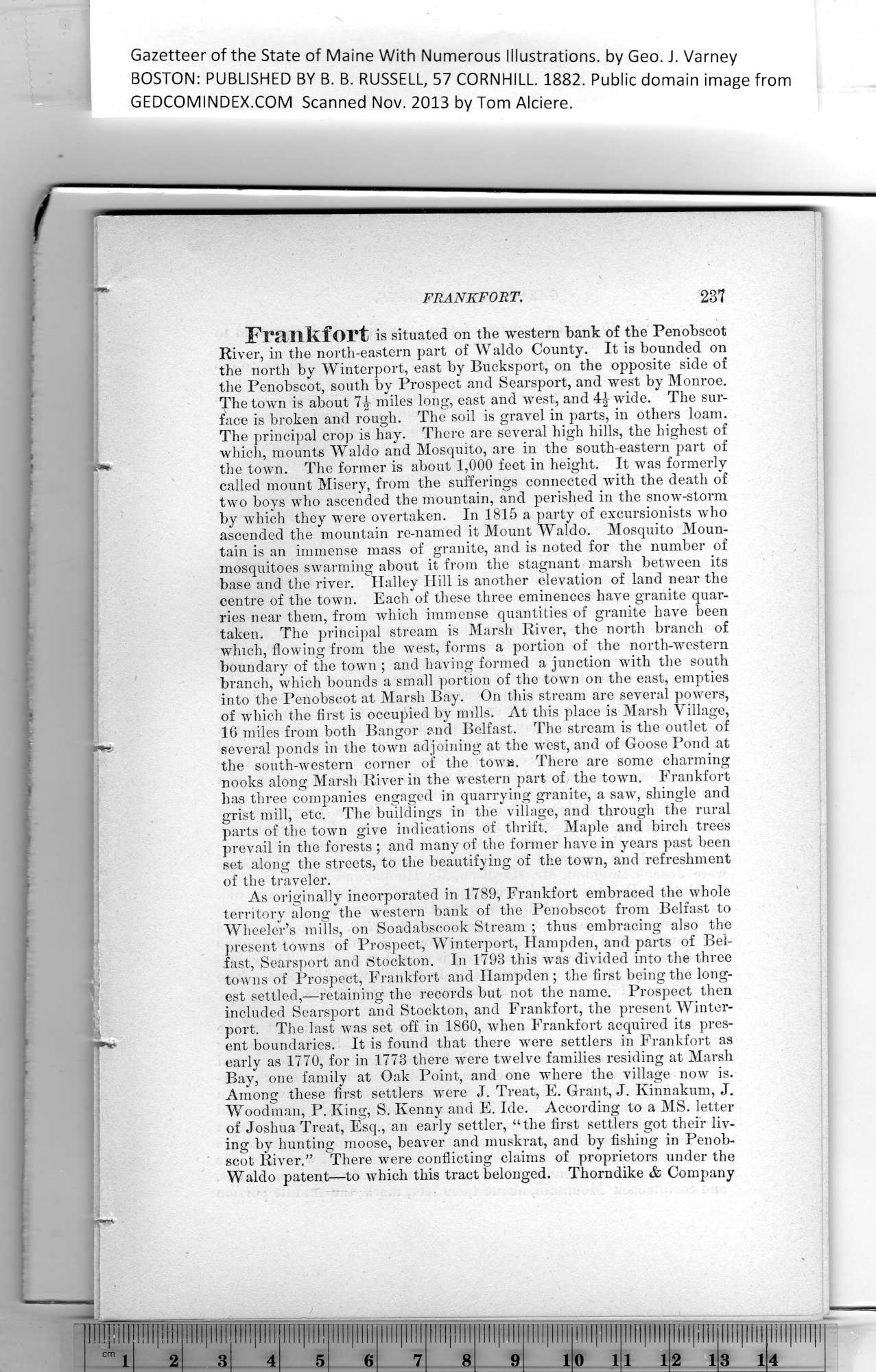|
Gazetteer of the State of Maine With Numerous Illustrations, by Geo. J. Varney
BOSTON: PUBLISHED BY B. B. RUSSELL, 57 CORNHILL. 1882. Public domain image from
Frankfort is situated on the western bank of the Penobscot
River, in the north-eastern part of Waldo County. It is bounded on
the north by Winterport, east by Bucksport, on the opposite side of
the Penobscot, south by Prospect and Searsport, and west by Monroe.
The town is about 7£ miles long, east and west, and 4|- wide. The sur-
face is broken and rough. The soil is gravel in parts, in others loam.
The principal crop is hay. There are several high hills, the highest of
which, mounts Waldo and Mosquito, are in the south-eastern part of
the town. The former is about 1,000 feet in height. It was formerly
called mount Misery, from the sufferings connected with the death of
two boys who ascended the mountain, and perished in the snow-storm
by which they were overtaken. In 1815 a party of excursionists who
ascended the mountain re-named it Mount Waldo. Mosquito Moun-
tain is an immense mass of granite, and is noted for the number of
mosquitoes swarming about it from the stagnant marsh between its
base and the river. Hailey Hill is another elevation of land near the
centre of the town. Each of these three eminences have granite quar-
ries near them, from which immense quantities of granite have been
taken. The principal stream is Marsh River, the north branch of
which, flowing from the west, forms a portion of the north-western
boundary of the town ; and having formed a junction with the south
branch, which bounds a small portion of the town on the east, empties
into the Penobscot at Marsh Bay. On this stream are several powers,
of which the first is occupied by mills. At this place is Marsh Village,
16 miles from both Bangor and Belfast. The stream is the outlet of
several ponds in the town adjoining at the west, and of Goose Pond at
the south-western corner of the tows. There are some charming
nooks along Marsh River in the western part of the town. Frankfort
has three companies engaged in quarrying granite, a saw, shingle and
grist mill, etc. The buildings in the village, and through the rural
parts of the town give indications of thrift. Maple and birch trees
prevail in the forests ; and many of the former have in years past been
set along the streets, to the beautifying of the town, and refreshment
of the traveler.
As originally incorporated in 1789, Frankfort embraced the whole
territory along The wmstern bank of the Penobscot from Belfast to
Wheeler’s mills, on Soadabscook Stream ; thus embracing also the
present towns of Prospect, Winterport, Hampden, and parts of Bel-
fast, Searsport and Stockton. In 1793 this was divided into the three
towns of Prospect, Frankfort and Hampden; the first being the long-
est settled,—retaining the records but not the name. Prospect then
included Searsport and Stockton, and Frankfort, the present Winter-
port. The last was set off in 1860, when Frankfort acquired its pres-
ent boundaries. It is found that there were settlers in Frankfort as
early as 1770, for in 1773 there were twelve families residing at Marsh
Bay, one family at Oak Point, and one where the village now is.
Among these first settlers were J. Treat, E. Grant, J. Kinnakum, J.
Woodman, P. King, S. Kenny and E. Ide. According to a MS. letter
of Joshua Treat, Esq., an early settler, “the first settlers got their liv-
ing hy hunting moose, beaver and muskrat, and by fishing in Penob-
scot River.” There were conflicting claims of proprietors under the
Waldo patent—to which this tract belonged. Thorndike & Company
PREVIOUS PAGE ... NEXT PAGE
This page was written in HTML using a program written in Python 3.2
|
